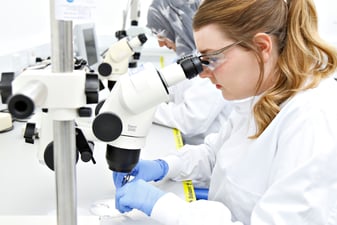Welcome to our new blog series on a REPROCELL 3D tissue engineering platform powered by Alvetex® technology. This series aims to inform and educate the research community and industry partners about the significance and benefits of cutting-edge bioengineered 3D human tissue model systems, which may be instrumental in facilitating translational research studies and accelerating the development of drugs and products.
Over the coming weeks and months, we are planning to explore the realm of bioinspired 3D in vitro human tissue engineering, using the example of our fabricated skin tissue equivalents. Moreover, we will address the biological relevance of these models, their robustness, predictive value, and compatibility with the analytical methods and clinical devices across various application domains. We will share evidence-based information and insightful visuals to help you understand the complexity, as well as the immense potential in this field of applied research.
Whether you are a curious researcher studying an intricate biological problem or a biopharma client faced with the limitations of the current experimental models to accurately test your investigational product, this series will improve your knowledge about these powerful microphysiological systems that could resolve many challenges in biomedical, pharmacology and cosmetics fields.
Reconstruction of Human Skin Tissue
As the largest, but also one of the most complex organs of our body, skin maintains homeostasis of all other internal organ systems by providing physical, biochemical, and immunologic barrier to the external environment. Native human skin is mainly composed of two distinct compartments, epidermis, and dermis as shown in Figure 1. The epidermis includes several cell types, predominately keratinocytes, which serve as the building blocks of the skin, but also pigment-producing melanocytes and antigen-presenting Langerhans cells and dermal macrophages. Histologically, the dermis comprises connective tissue containing extracellular matrix (ECM)-producing dermal fibroblasts, macrophages and other immune cell subsets, blood vessels, skin appendages, and nerve endings. Thus, reconstruction of the skin tissue complexity and its cellular diversity in vitro is quite challenging, resource-intensive and time-consuming. However, in the past two decades, major progress in skin tissue engineering has been made, and there are now multiple commercial three-dimensional (3D) skin tissue substitutes available.

Figure 1. The main tissue layers and cellular diversity of native human skin. The human epidermis consists of four cell layers: the stratum basale (SB), the stratum spinosum (SS), the stratum granulosum (SG), and the stratum corneum (SC). The epidermal barrier is composed of several elements: the SC serves as the air-liquid interface (ALI) barrier, the tight junctions mainly located in the SG act as a diffusion barrier, and the network of Langerhans cells forms the immunological barrier.
Limitations of Conventional Skin Models
Two-dimensional (2D) culture of skin cells provides a reductionist approach that may generate insights into cutaneous biology. However, unsurprisingly, they largely fail as predictive in vitro experimental models in drug screening. This is primarily due to the lack of proper cell mechanics and 3D cell shape, the aberrant behaviour of flattened cells, and their altered gene expression patterns 1-3. Furthermore, complex intercellular interactions, molecular signals and distinct extracellular matrix milieus seen within the native skin were absent in these adherent cell monolayers 1.
Conversely, animal models have historically been integral to dermatologic research. The utilisation of animal models was a longstanding practice in the field. However, a large body of evidence demonstrated a lack of biological correlation between the skin of humans and experimental animals, due to their genetic, structural, and functional differences. In addition, from an ethical standpoint, there are many regulatory initiatives to promote animal welfare and reduce, replace, or refine (3R principle) animal experimentation 1, 3. This resulted in the total ban on animal testing for cosmetic products within the European Union in 2013 1.
With an increasing prevalence of skin disorders worldwide, growing demand for novel drugs and personal skincare products, constraints of 2D monolayer cultures and animal models, and limited availability of ex vivo explant cultures, the use of tissue engineering technologies is crucial to fabricate a more physiologically relevant and highly reproducible in vitro human skin models for pharmaceutical research (see Figure 2).

Figure 2. In vitro, ex vivo, and in vivo approaches in dermatologic research.
Advantages of REPROCELL Bioengineered Human Skin Equivalents
The most common organotypic 3D in vitro skin models are full-thickness human skin equivalents (FT-HSEs). They are typically engineered over a few weeks using co-cultured primary keratinocytes and fibroblasts at the air-liquid interface (ALI) (see Figure 3) 1, 4, 5. This biofabrication process is made possible by various hydrogels and physical scaffolds. Both natural and artificial hydrogels as well as supportive scaffolds can facilitate the reconstruction of a functional dermo-epidermal junction zone including basal membrane. Complementarily, the growth at the ALI promotes proper proliferation, differentiation, stratification and cornification of keratinocytes in vitro. If a 3D construct includes only one skin tissue compartment, it is classified as either human epidermal equivalent (HEE), composed exclusively of epidermal cells, or human dermal equivalent (HDE), composed exclusively of dermal components.
REPROCELL has pioneered innovative bioengineering platforms with its market-leading Alvetex® technology, developed by Prof. Stefan Przyborski and his team at Durham University, UK. Alvetex® technology is comprised of a highly porous, biocompatible polystyrene-based scaffold membranes, enabling a seamless transition from 2D to 3D culture systems. This technology transcends traditional 3D cell culture and offers unmatched flexibility, integrating seamlessly to fit conventional tissue culture plasticware, thus enhancing its bioengineering capabilities. Our recent technological advancements, including a novel Alvetex®-based insert design and an innovative tissue seal between the upper and lower compartments of the culture system, have improved handling and access to the model surface. These features, along with exceptional compatibility with clinical testing devices, have led to the development of off-the-shelf tissue constructs that closely mimic human skin, commercially known as REPROSKIN™.

Figure 3. Schematic view of constructing the in vitro human skin equivalent including haematoxylin and eosin (H&E) stained section. Adapted from Roger et al., 2019 1.
REPROSKIN™ engineered human skin offers several key advantages compared to conventional 3D in vitro skin culture systems:
- Robustness and resilience of human skin equivalents: We manufacture the most biologically accurate and robust off-the-shelf FT-HSEs over a period of four to five weeks. Our HSEs recapitulate mechanical, structural, and functional features of real skin tissue in an unprecedented manner (see Figure 3) 1, 4, 5. Their excellent biomimetic properties and structural integrity are validated and extensively characterised at molecular, cellular and tissue levels. As a cutting-edge testing platform, REPROSKIN™ facilitates comprehensive investigations into various aspects of skin biology and pathology. It allows the studies of gene expression and protein secretion, cellular senescence, cell-cell interactions, deposition and remodelling of ECM, inflammatory pathways and their mediators, regulation of epidermal proliferation and differentiation, skin pigmentation patterns and mechanisms of photoaging, skin barrier function and repair, as well as the impact of various environmental exposures on skin health and appearance 1, 4.
- Reproducibility and controllability of skin bioengineering: A key attribute of REPROSKIN™ is its fully optimised skin bioengineering protocol, enhancing model functionality, scalability and applicability. This comprehensive optimisation encompasses:
- The selection of a stable biomechanical support using Alvetex® scaffolds. Alvetex® unique synthetic membranes provide ample space and proper geometry for in vivo-like cell growth, migration, and the establishment of intercellular communication, notably endogenous ECM deposition from the primary dermal fibroblasts. Consequently, this ensures the maintenance of the models’ biomimetic properties and organotypic architecture over extended periods, making them morphologically and functionally highly comparable to native human skin;
- The specificity of cellular material used for skin model fabrication and the appropriate cell seeding densities are vital factors for the scalability and longevity of our bioengineered skin. REPROSKIN™ is entirely comprised of low-passage primary human cells isolated from either adult or neonatal skin. Additionally, it can incorporate other skin-relevant cell lines, such as primary melanocytes, or the human acute myeloid leukaemia cell line MUTZ-3, which serves as Langerhans-like cells or THP-1-derived macrophage-like cells. Our unique 3D skin constructs and innovative bioengineering approach precisely address the required skin cell types and their optimal numbers, tailored to the model’s specific application. This includes physiologically relevant cellular interactions and a broad spectrum of phenotypes in both homeostatic and disease-like conditions. Our biofabrication process also considers the influence of batch-to-batch variability to minimise any material-based variation, ensuring the highest level of physiological relevance and meeting specific requirements for downstream applications of the engineered skin equivalents 1.
- Building reliable and consistent 3D skin models in vitro depends greatly on the composition of 3D cell culture media and its supplementation. It is well-documented that chemical and physical cues can significantly modulate cell proliferation and differentiation in both 2D and 3D settings 5, 6. REPROCELL addresses these common in vitro culture challenges by using chemically defined, animal-component-free and serum-free skin culture media and high-quality, reliable formulations of supplements, in conjunction with Alvetex® scaffolds. As mentioned before, Alvetex® membranes promote consistent recreation of skin tissue-specific ECM, enabling physiologically relevant interactions and the establishment of niche microenvironments during the coculture of skin cell types. This setup sustains cell proliferation and maintains cell metabolism closer to in vivo The absence of animal products and serum in the media, combined with proper supplementation of ions, small molecules, and growth factors, balances cell responses and energy homeostasis and overall optimises epidermal cell growth at the ALI. This results in a fully formed, keratinised epidermis two weeks after seeding keratinocytes. Thus, the bioengineering of REPROSKIN™ is a gradual, optimal, and anatomically accurate process, with the skin equivalent remaining viable in culture for several weeks.
The reproducibility, controllability and longevity of REPROSKIN™ are essential for their utilisation in pre-clinical research, cosmetic safety and toxicity assessments, or drug discovery and product development.
- Versatility and compatibility in testing: REPROSKIN™ models are fabricated in scalable cell culture inserts compatible with various conventional cell culture plasticware formats, including 6-well, 12-well, and 24-well plates. Moreover, these custom-manufactured inserts, containing live skin models, can be easily transferred between different plate formats without disruption, enhancing the flexibility of the test platform. This high-throughput adaptability, combined with compatibility with current clinical instrumentation, enables a wide array of downstream applications and end-point assays. These include studying skin homeostasis, ageing, regeneration, and disease-like conditions, evaluating efficacy and safety in dermatologic drug discovery, and testing novel cosmetic formulations, devices, or procedures1, 4, 7.
REPROCELL’s HSEs undergo rigorous standardised quality control (QC) analyses to ensure they accurately replicate the complexity and behaviour of native human skin. These tests include molecular screening (genomics, transcriptomics, proteomics), cellular profiling (light and fluorescent microscopy, ultrastructural insights via scanning (SEM) and transmission electron microscopy (TEM), immunophenotyping and cytokine release measurements, quantitative or biochemical assays such as transepidermal water loss (TEWL), transepidermal electrical resistance (TEER), and dye penetration tests, as well as routine histological characterisation including paraffin embedding, cryosectioning, haematoxylin and eosin staining, and immunohistochemistry. Our skin equivalents are compatible with most end-point analyses performed on biopsied human skin as well as clinical tools used to monitor and assess skin parameters in health and disease. For instance, the REPROSKIN™ surface can be exfoliated using a tape stripping technique or exposed to physical and chemical insults such as ultraviolet radiation (UVR) or topical irritants to generate controlled scratches, cuts, wounds, and burns. Thus, REPROSKIN™ serves as a biologically relevant and accurate predictive testing platform, effectively bridging the gap between in vitro research and clinical practice.
REPROSKIN™ – a versatile platform for skin research and product development
In addition to clinical research with real patients and live human skin tissue ex vivo, utilising 3D human skin equivalents provides the most physiologically representative in vitro platform for assessing drug safety and efficacy. This approach is available through contract testing services and is also invaluable for investigating the effects of various environmental exposures and cosmetic formulations on skin appearance and health. REPROSKIN™, our market-leading engineered 3D miniature skin models closely replicate native human cutaneous biology. By leveraging REPROSKIN™, we offer a more reliable and predictive testing system, providing time-saving and cost-effective solutions, as well as unparalleled customisation without the ethical concerns associated with animal testing.
Our cutting-edge platform can significantly accelerate the preclinical phase of drug discovery and enhance skincare product development (Figure 4). This aligns perfectly with the growing demand from customers for ethical, highly predictive, and biologically accurate in vitro skin models, especially given the limited availability of ex vivo human skin for research purposes.

Figure 4. Main characteristics and applications of REPROSKIN™ in dermatologic research.
Cosmetic dermatology
During the past decade, the skincare and beauty market has expanded substantially and rapidly, increasing the demand for more accurate, sustainable, and high-throughput human skin-relevant testing systems that alleviate ethical concerns. Consequently, replicas of human skin have become instrumental for evaluating skincare products by assessing their safety, effectiveness, and user-friendliness through the study of key characteristics such as pigmentation, permeation, exfoliation, absorption, and hydration. These features can significantly influence skin function, colouration/tone, ageing rate and patterns, and overall skin health and appearance.
Therefore, we have developed sophisticated REPROSKIN™ HSEs designed to improve the evaluation of cosmetic formulations, tools, routines and procedures. Our impaired barrier/skin damage models, combined with the tape-stripping method, can simulate various types of damage to the skin barrier. These reconstructed skin models allow for the assessment of the effectiveness and permeation of skincare topicals or cosmetic devices by analysing their structural and functional changes (Figure 5). Typically, the epidermal barrier of the miniature skin model is challenged or damaged in a controlled manner, which can be measured precisely, for instance, through TEWL records. Subsequently, the barrier repair process and skin healing are monitored in the absence or presence of skincare products, such as creams, gels, lotions, ointments, foams, or patches, for up to 14 days. This approach, generating large relevant data sets, is particularly useful for evaluating different topical personal care formulations. Thus, our recent study provided valuable insights into skin exfoliation and restoration through the assessment of various shaving and grooming products 7.

Figure 5. Tape stripping of bioengineered REPROSKIN™ impaired barrier/skin damage models. Adapted from Costello et al., 2023 7. The number of tape strips correlates with level of epidermal barrier damage. H&E staining of HSEs immediately following insult (0 hours) ranging from 0–10 tape strip removed, and after a 4-day recovery period. Transepidermal water loss (TEWL) increased with increasing number of tape strips immediately following the barrier disruption and recovered over the 4-day period.
Furthermore, our second pipeline of REPROSKIN™ HSEs consists of pigmented skin models that incorporate melanocytes with characteristic dendrites extending to connect with numerous keratinocytes. The melanin pigment is stored within keratinocytes in the perinuclear area as supranuclear “caps,” mirroring this phenomenon seen in real human skin. These models have demonstrated exceptional predictive capabilities across a wide range of applications, particularly in examining the influence of detrimental UVR on different skin phototypes, skin colouration (both darkening and lightening) and ageing patterns. Additionally, they are valuable for evaluating the protective effects of sunscreen products and skin tanning/whitening formulations, as detailed in our latest publication 8 and accompanying blog post (Figure 6).

Figure 6. Schematic representation of REPROSKIN™ pigmented HSEs and their applications.
Skin ageing and regeneration
Two crucial aspects of skin health and longevity are ageing and wound healing. To address these, REPROCELL has invented and optimised ageing skin models to evaluate skin ageing parameters and age-related skin deterioration 9. This is achieved through the utilisation of senescent cells from donors over the age of 50 in skin model fabrication (Figure 7). Both epidermal thinning and the decline in dermal ECM production, due to reduced cell proliferation rate and activity, can be emulated in vitro through this innovative bioengineering strategy. Our data clearly show that the structural changes observed in ageing skin in vivo can be closely recapitulated within our model. This facilitates numerous studies to assess various senolytics (anti-ageing drugs), including small molecules, senotherapeutic peptides, and retinoids.

Figure 7. Simulating the ageing process with the REPROCELL ageing skin model. H&E staining reveals distinguishable tissue-level changes between REPROSKIN™ juvenile and aging models, attributed to variations in skin cell activity and gene expression patterns, primarily driven by changes associated with cellular senescence in older donors.
Cutaneous wound healing is a prerequisite for human survival and maintaining a good quality of life. Numerous wound-related pathologies, such as skin ulcers, keloids, hypertrophic scars, and burns, impose significant socioeconomic and health burdens. To address this, we have established a robust and fully customisable in vitro testing platform utilising REPROSKIN™ damage models. This platform employs specialised tools to create acute wounds or trauma in a precise and controlled manner, including razors (for nicks and scratches), scalpels (for cuts), cryoinjury probes (for cold burns), and soldering irons (for burns). These tools allow us to assess various aspects of the wound healing process, closely simulating real-life skin injury scenarios. Extensive data sets obtained from the mechanical stimulation of our FT-HSEs demonstrate their reliability as experimental wound-healing models. These pre-clinical models are invaluable for examining the protective and regenerative properties of cosmetic treatments and pharmaceuticals.
Dermatologic drug discovery and skin disease modelling
Skin conditions are omnipresent with dramatically fast-rising prevalence, currently affecting nearly one-third of the global population. To tackle this growing issue, the use of sophisticated and standardised 3D in vitro skin models, such as REPROSKIN™ HSEs engineered through the Alvetex® technology, is essential for effective disease modeling and drug discovery endeavours. Our 3D in vitro skin models not only provide accurate predictive data but also help reduce clinical trial costs. Both topical agents and compounds administered in culture media can be evaluated accurately and consistently using our HSEs. Additionally, our bespoke cultureware formats, highly compatible with clinical testing instruments, enhance high-throughput screening capacity and analytical resolution.
In the context of disease modeling, REPROCELL’s skin tissue constructs can also be tailored to build both immunocompetent and neurosensory skin models 10. By incorporating relevant immune cells into the system, such as the MUTZ-3 cell line (acts as Langerhans cell analogue) or THP-1-derived macrophages, our immunocompetent HSEs have been instrumental in investigating immune responses to allergens, irritants or pollutants. They can even mimic immune-mediated skin pathology seen in common skin disorders like atopic dermatitis. Similarly, we have developed neurosensory HSE by integrating functional sensory-like neurons into dermal equivalent (Figure 8). This allows us to emulate skin neurosensitisation, commonly seen in the itchy skin of eczema patients, as well as skin irritation and adverse reactions to topical therapies or cosmetic products.

Figure 8. Incorporation of sensory-like neurons to dermal compartment to engineer a functional neurosensory FT-HSE. Adapted from Freer et al., 2024 10. Neurons were cultured on the surface of a dermal equivalent for 7 days before the seeding of keratinocytes and the formation of an epidermal compartment. Sensory neurons were successfully integrated into the FT‐HSE, with perikarya or neuronal cell bodies prominently visible (indicated by arrows) directly beneath the epidermis, as visualised by H&E staining. The presence of neurons did not affect the epidermal thickness within the FT-HSE (refer to the graph). Immunofluorescence staining of native human skin for the neuronal biomarker PGP (green) and the keratinocyte biomarker keratin-14 (KRT14, red) revealed neuronal cell bodies located within the dermis, with neurites extending into the epidermis and interacting with keratinocytes. A similar pattern was observed in the neurosensory FT-HSE, where immunofluorescence staining for PGP (green), KRT14 (red), and pan-neuronal marker TUJ-1 (green) indicated potential sensory neurite-keratinocyte interactions.
Furthermore, we have successfully incorporated melanoma cells into the epidermal compartment of HSE, thus creating a robust and predictive skin cancer model 11. This model not only enhances our understanding of the invasive behaviour of metastatic melanoma but can also facilitate the evaluation of potential therapies for their efficacy and safety.
Conclusion
As the scientific community gravitates toward interdisciplinary approaches and advanced technologies to tackle current and future challenges in medicine and pharmacology, REPROSKIN™ tissue models emerge as a key innovation in bioengineering. Our miniature skin replicates offer several advantages over conventional 3D in vitro skin culture systems, making REPROSKIN™ a robust, reproducible, controllable, and long-lasting testing platform for numerous downstream applications. These substantial qualities make it an invaluable tool for pre-clinical research, cosmetic safety and toxicity assessments, as well as drug discovery and product development.
Our unwavering commitment to continuous innovation and refinement of bioengineering technologies ensures that REPROCELL remains at the forefront of developing engineered skin tissue-like surrogates. By leveraging the strengths of REPROSKIN™, we are proud to contribute to a better understanding of skin conditions and their treatments, ultimately leading to more effective and personalised healthcare solutions and safer cosmetic and skincare products.
References
- Roger, M., Fullard, N., Costello, L., Bradbury, S., Markiewicz, E., O'Reilly, S., Darling, N., Ritchie, P., Määttä, A., Karakesisoglou, I., Nelson, G., von Zglinicki, T., Dicolandrea, T., Isfort, R., Bascom, C., & Przyborski, S. (2019). Bioengineering the microanatomy of human skin. Journal of Anatomy, 234, 438–455.
- Jorgensen, A. M., Mahajan, N., Atala, A., & Murphy, S. V. (2023). Advances in Skin Tissue Engineering and Regenerative Medicine. Journal of burn care & research: official publication of the American Burn Association, 44(Suppl_1), S33–S41.
- Moniz, T., Costa Lima, S. A., & Reis, S. (2020). Human skin models: From healthy to disease-mimetic systems; characteristics and applications. British journal of pharmacology, 177(19), 4314–4329.
- Costello, L., Fullard, N., Roger, M., Bradbury, S., Dicolandrea, T., Isfort, R., Bascom, C., & Przyborski, S. (2019). Engineering a Multilayered Skin Equivalent: The Importance of Endogenous Extracellular Matrix Maturation to Provide Robustness and Reproducibility. Methods in molecular biology (Clifton, N.J.), 1993, 107–122.
- Randall, M. J., Jüngel, A., Rimann, M., & Wuertz-Kozak, K. (2018). Advances in the Biofabrication of 3D Skin In Vitro: Healthy and Pathological Models. Frontiers in bioengineering and biotechnology, 6, 154.
- Aleemardani, M., Trikić, M. Z., Green, N. H., & Claeyssens, F. (2021). The Importance of Mimicking Dermal-Epidermal Junction for Skin Tissue Engineering: A Review. Bioengineering (Basel, Switzerland), 8(11), 148.
- Costello, L., Goncalves, K., Maltman, V., Barrett, N., Shah, K., Stephens, A., Dicolandrea, T., Ambrogio, I., Hodgson, E., & Przyborski, S. (2023). Development of a novel in vitro strategy to understand the impact of shaving on skin health: combining tape strip exfoliation and human skin equivalent technology. Frontiers in medicine, 10, 1236790.
- De Los Santos Gomez, P., Costello, L., Goncalves, K., & Przyborski, S. (2024). Comparison of photodamage in non-pigmented and pigmented human skin equivalents exposed to repeated ultraviolet radiation to investigate the role of melanocytes in skin photoprotection. Frontiers in medicine, 11, 1355799.
- Costello, L., Goncalves, K., De Los Santos Gomez, P., Simpson, A., Maltman, V., Ritchie, P., Tasseff, R., Isfort, R., Dicolandrea, T., Wei, X., Määttä, A., Karakesisoglou, I., Markiewicz, E., Bascom, C. C., & Przyborski, S. (2023). Quantitative morphometric analysis of intrinsic and extrinsic skin ageing in individuals with Fitzpatrick skin types II-III.
- Freer, M., Darling, N., Goncalves, K., Mills, K. J., & Przyborski, S. (2023). Development of a mammalian neurosensory full-thickness skin equivalent and its application to screen sensitizing stimuli. Bioengineering & translational medicine, 8(3), e10484.
- Hill, D. S., Robinson, N. D., Caley, M. P., Chen, M., O'Toole, E. A., Armstrong, J. L., Przyborski, S., & Lovat, P. E. (2015). A Novel Fully Humanized 3D Skin Equivalent to Model Early Melanoma Invasion. Molecular cancer therapeutics, 14(11), 2665–2673.
.png?width=1280&height=720&name=Untitled%20design%20(1).png)


.jpg?width=1000&height=562&name=Untitled%20design%20(5).jpg)

.jpg?width=1000&height=562&name=blog%20images%20(1).jpg)


